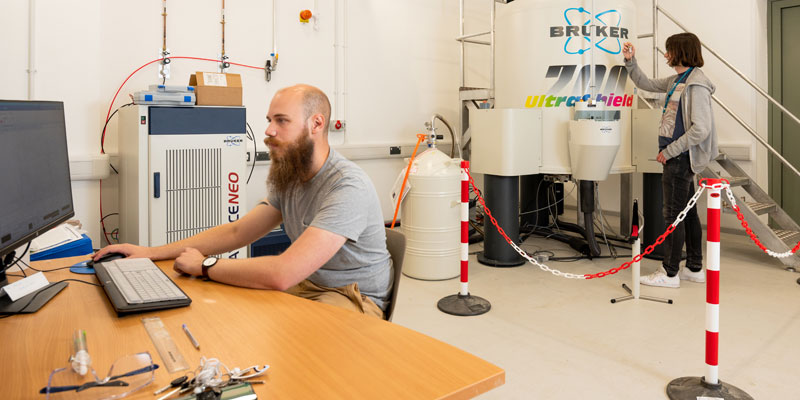
Nuclear magnetic resonance spectroscopy
High-resolution and -sensitivity, Liquid-state NMR Spectroscopy
The facility houses a Bruker 700 MHz NMR spectrometer equipped with a triple resonance Prodigy cryoprobe and temperature-controlled sample changer.
This affords the sensitivity and resolution to characterise complex biological molecules including proteins, nucleic acids and carbohydrates.
NMR spectroscopy can play several roles in protein structural biology studies:
- It can provide fast, non-destructive characterisation of protein samples, useful for quality control and stability analysis
- NMR can provide a 'fingerprint' of a protein, based on the 15N-HSQC experiment. This provides a 2D spectrum which is sensitive to changes in structure, binding of ligands or other proteins
- Detailed structural characterisation of small to medium sized proteins is possible using NMR (up to approximately 25 kDa). The collection of atomic resolution distance restraints (NOEs) allows calculation of the 3D structural ensemble, which can be validated using further data such as residual dipolar couplings (RDCs)
- NMR allows residue-level measurement of protein dynamics and exchange between conformations
- NMR provides tools for characterising intrinsically disordered sequences that are inaccessible to other techniques, including finding interaction sites and regions of transient secondary structure
- NMR can be used for high-throughput screening of compound or fragment libraries for interactions with a target protein. This is possible even for large proteins, and does not require high protein concentrations.
Sample preparation
While no special preparation is needed for simple characterisation methods, more advanced techniques require 15N and or 13C isotope-labelled protein. These samples are simple to prepare for proteins produced in bacterial expression systems, and we can provide advice, training and recipes for growth media.
Training
Full practical training is provided, both in using the spectrometer and data analysis. In addition, we run a course every September covering the theoretical basis of NMR, and are happy to discuss any specific techniques you may need.